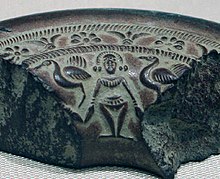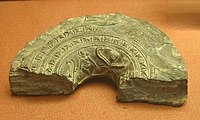Ringstone



The ringstone is a distinctive type of artefact and miniature sculpture made in India during the approximate period of the Mauryan Empire (c. 322–185 BCE) and the following Sunga Empire (187–78 BCE). They are usually dated to the 3rd or 2nd centuries BCE.[3] They are shaped like a doughnut, but with straighter sides, and flat and plain on the bottom. They are in stone, with the top side very finely carved in relief with several circular zones of decoration running around the hole in the centre. When complete, they are about 2.5 to 4 inches (64 to 102 mm) across.[4]
Their purpose, and any practical function, remains unclear and "enigmatic". They may have a specific religious purpose, or a more general one promoting fertility, or been used to make jewellery by pressing metal foil over the designs.[5] About 70 have been found,[6] many only as fragments, with a 2014 find in Thailand the first from outside the Indian subcontinent; it is assumed this was imported from India.[7]
Ringstones were first noticed by Alexander Cunningham, who published one in the late 19th century. By the time of S.P. Gupta's survey of 1980, at least 32 ringstones and 36 discstones were recorded; the numbers have continued to rise.[8]
Decoration[]
The designs vary, but all examples are finely carved, despite their small size. A number of components appear in a variety of arrangements. Typically the innermost zone, which runs down the sloping sides of the hole, has four standing female figures, usually nude "with fully exposed genitalia" and heels together, but with jewellery and elaborate hairstyles, with trees in between them.[9] These may be called "goddesses", or "mother goddesses", and the trees, apparently of various species, may be described as the tree of life, but these interpretations are not universally accepted.[10]
The example in the Cleveland Museum of Art, where the three pairs of female figures have wide skirts, then has a cable or rope pattern border, then a zone of animals in profile, with their feet on the inside. After another rope border there is a circle of "cross-and-reel" motifs, then a final rope border before a plain and smooth outer zone. This is more elaborate than most examples, which are often similar, but without the animal zone.[11] The example found in Thailand has an animal zone but no "cross-and-reel" one,[12] whereas those in the V&A and British Museum each have two of them, but no animals. In one example the animals are "lizards or crocodiles".[13]
A somewhat similar ivory disc with a hole only has the standing figures in its single zone. It is dated to the 2nd century BCE.[14]

Complete example in the Cleveland Museum of Art (detail above)
Goddesses and plants, British Museum.[15]

Metropolitan Museum of Art, New York, with "Goddesses and Palm Trees".[16]
Purpose[]

Various purposes and uses for ringstones have been proposed, but without any gaining general acceptance. One suggestion is that they were matrices for moulding by beating thin sheets of metal, probably gold foil, as jewellery, which has always been important in Indian culture, but has very few survivals from ancient times.[18] Though not liked by some scholars,[19] this theory may have gained some ground with the 2014 find in Thailand, which was found near fragments of thin gold foil, one of which had an animal pattern very similar to that on the ringstone.[20]
It is agreed that the ringstones themselves are too heavy to have been worn, although this had been suggested by Ananda Coomaraswamy. They may have been objects for use in meditation,[21] or it has been suggested they were used as a "physical contraceptive device",[22] or somehow connected with fertility.[23]
Some examples have brief and informal inscriptions on the blank bottom, which have mostly not yet yielded their meaning.[24]
Geographical range[]
Apart from the recent Thai find, the findspots range (like Mauryan territory) across north India, from Taxila in the Punjab (now Pakistan) in the north-west to Patna, Bihar in the east; most have been found in urban centres on the Grand Trunk Road, such as these.[25] As they are easily portable, and have very consistent characteristics, they may all have been made in a single centre, for which Pataliputra (now Patna), the capital of the successive Mauryan and Sunga empires, is one obvious candidate.[26]
Discstones[]
The ringstone seems to have developed into the discstone, which is similar in shape, but with a flat top with a plain circular space in the middle, rather than an actual hole. They are also in stone, but not quite as precisely carved, with mostly plant-based decoration that is not divided in narrow circular zones in the same way. The example illustrated has relatively simple decoration, with narrow tendril-like elements. Discstones are usually dated to the 1st century BCE.[27]
A discstone was recently found in Myanmar.[28]
Collections[]
The largest collection of ringstones is in the Patna Museum,[29] and other large Indian museums have examples. Several major museums outside India have examples, including the Metropolitan Museum of Art (3), Cleveland Museum of Art, British Museum (2), Berlin State Museums, Victoria and Albert Museum in London (the only example with a provenance, from Taxila), and LACMA.[30] A number are in private collections, and at least three have been on the art market in the 2010s.[31]
Notes[]
- ^ Lerner and Kossak, 50, their no. 2
- ^ Lerner and Kossak, 50, their no. 4
- ^ Lerner and Kossak, 48; Bennett (2017); V&A
- ^ Lerner and Kossak, 48–50; V&A. They may also be called "ring stones" or "ring-stones"
- ^ Lerner and Kossak, 48 (quoted); Bennett (2019), 99; V&A
- ^ Bennett (2017)
- ^ Bennett (2019), 95; Bennett (2017)
- ^ Bennett (2019), 95
- ^ Lerner and Kossak, 48; Bennett (2019), 96 (quoted)
- ^ Lerner and Kossak, 48; V&A; Bennett (2019), 96; Siudmak; Both the first two have decided that the hairstyles are wigs.
- ^ Lerner and Kossak, 48
- ^ Bennett (2017)
- ^ Siudmak
- ^ Ball
- ^ British Museum page
- ^ Lerner and Kossak, 49, no. 3
- ^ Lerner and Kossak, 50–51, no. 7
- ^ Bennett (2019), 83–87, 99
- ^ Lerner and Kossak, 48; V&A
- ^ Bennett (2019), 99; Bennett (2017)
- ^ Lerner and Kossak, 48; Bennett (2017)
- ^ Bennett (2017) (no details given as to how this might work)
- ^ Lerner and Kossak, 48; V&A
- ^ Bennett (2019), 104-105
- ^ Bennett (2019), 95; V&A; Bennett (2017)
- ^ V&A
- ^ Lerner and Kossak, 50–52
- ^ Bennett (2019), 99
- ^ Bennett (2017), 95
- ^ Bennett (2019), 96–98, 100–101 (with photos)
- ^ Bennett (2019), 101 (all with John Siudmak)
References[]
- "Ball", "Unidentified Artist, Northeast Indian (Sunga Dynasty)", David Owsley Museum of Art Collection, Ball State University (Ivory ring)
- Bennett, Anna (2017), "Sunga ringstone found in Thailand"; photos of lecture slides
- Bennett, Anna (2019), "Suvarnabhumi, "Land of Gold"", in Suvarnabhumi, the Golden Land, 2019, GISDA, PDF
- Lerner, Martin and Kossak, Steven, The Lotus Transcendent: Indian and Southeast Asian Art from the Samuel Eilenberg Collection, 1991, Metropolitan Museum of Art (New York, N.Y.), ISBN 0870996134, 9780870996139, google books
- Siudmak, John, Catalogue No. 5, "Indian and Himalayan Sculpture", 2016, Calalogue No. 2,
- "V&A": "Ring stone" in collection
Further reading[]
- Gupta, S.P., The Roots of Indian Art: Detailed Study of the Formative Period of Indian Art & Architecture – 3rd & 2nd Century BC, 1980 (includes a survey of all examples then known)
- Irwin, J., "Late Mauryan or early Sunga ring-stones", Journal of the Royal Asiatic Society, April 1951, pp.1–3
| Wikimedia Commons has media related to Ringstones. |
- Mauryan art
- Shunga Empire
- Indian sculpture
- Hardstone carving


